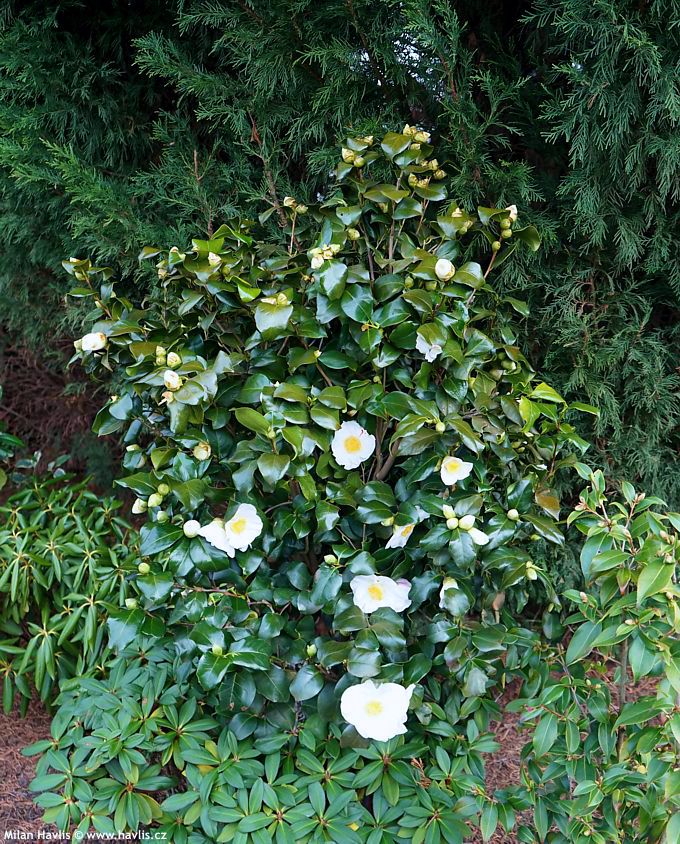Camellia japonica 'ALBA SIMPLEX' hardy camellia
Camellia
Dreams usually come true when you no longer accept when others say that this or that is impossible. It is often connected with the fact that no one has tried it before or tried hard and long enough. In the horticultural world this is exactly what pushes the boundaries, especially when it comes to hardiness. For example, until recently it was believed that none of the subtropical species would have had a chance to make it through the continental winters. Such as silk tree. And now? Many gardeners enjoy its immense beauty in their gardens surviving -25 °C without a minor damage. Exactly the same applies to evergreen magnolia where possibly at the same time there were breeders selecting their hardy varieties. Elsewhere there were a few camellia enthusiasts working on the identical issue.
Camellias would probably have remained the feature of southern countries had not come the harsh winters of the 1970's and 1980's. In the USA many of them were killed during some of these winters, and they were not all grown at the borderline of their hardiness. Two botanists who witnessed this fiasco decided to breed hybrids and varieties that would withstand harder frost not only in their former environment but also in countries up north. Dr. Clifford R. Parks of the North Carolina University spent his time on breeding mostly spring flowering camellias (japonica species and hybrids), and he is famous for the April series. The other visionary was dr. William Ackerman (†2013), a retired USDA botanist from Ashton. Ackerman recognized his calling when in spring 1978 only 15 plants survived out of originally cultivated 956 specimens and he changed his of from breeding only fragrant camellias to hardy camellias. He mostly focused on autumn flowering hybrids and sasanqua species and his famous series are Winter and Ashton.
Even though parentage of many plants which are most probably hybrids is untraceable today we stick to accepted names be it c. japonica or c. sasanqua. Interesting fact is that camellia was named after a Czech (Moravian) botanist George Joseph Kamel (†1706), a missionary in the Philippines in late 1600's whose work was so contributive that Carl Linnaeus decided to name camellia in his honour several decades after his death. So Kamel had no chance to see the plant as it was first brought to Europe in 1739 and was not present in the flora of Philippines.
Alba Simplex is a spring flowering hardy camellia whose origin, despite the availability of multiple historical sources, is rather uncertain. One source claims that it comes from China but does not support it with any further details. Another source says it comes from Germany, registered in 1816, and later, given various years of introduction, it was described in other independent magazines as Alba, Alba Flore Simplici, Alba Simple, etc. We tend to believe the third source which describes it as a chance seedling of Variegata, a semi-double variety that was discovered and raised by Mr. Rollinson in his nursery in Tooting, London, UK, and introduced in 1813.
All its alternative names (synonyms) refer to a snow-white colour and a simple flower arrangement. Though, the flowers often have a stripe or a narrow brushstroke in light to medium strong pink colour. They come out from late March for 6-8 weeks, until the shrub has flower buds and there are usually many of them. Leaves are evergreen, broadly ovate and large: 10-12 cm long, gently serrated at margins, deep green, and glossy. Alba Simplex makes chubby, dense, upright shrubs and grows slowly to moderately. Pruning is possible in spring after flowering.
Cultivation
Camellias need similar planting like rhododendrons - once you plant them well you need not care for them. They require fresh, ericaceous (acid), peat-based, humus-rich soil that will never dry out but will not be water-retaining like clay. Even moisture and good drainage are key demands for good root growth. We strongly suggest using mycorrhizal fungi when planting. Never plant it too deep and if your soil is clay elevate the root ball accordingly. Fertilizing is recommended after flowering, once a month until late summer.
Crucial is finding a good location and finding one for good - camellias detest transplanting. In the wild they grow under canopies of tall trees or at woodland margins. They dislike direct sunlight and both excess heat in summer and drying winds in colder months. Find a place at the back of the house away from winter and spring sunlight, sheltered from the north-west, or behind a tall hedge with some trees nearby to cast at least dappled shade during summer. Ever seen a camellia in full sun at the seaside? Remember that the air is so humid there that plants do not suffer from drying rays as they keep on drinking all day long. Before it establishes which might take 2-3 years provide enough moisture also in winter in the ground is not frozen but don't overwater! Mulch it well with bark mulch 5-10 cm high. Suggested hardiness is -20 °C to -23 °C (USDA zone 6).
Last update 13-11-2023











































